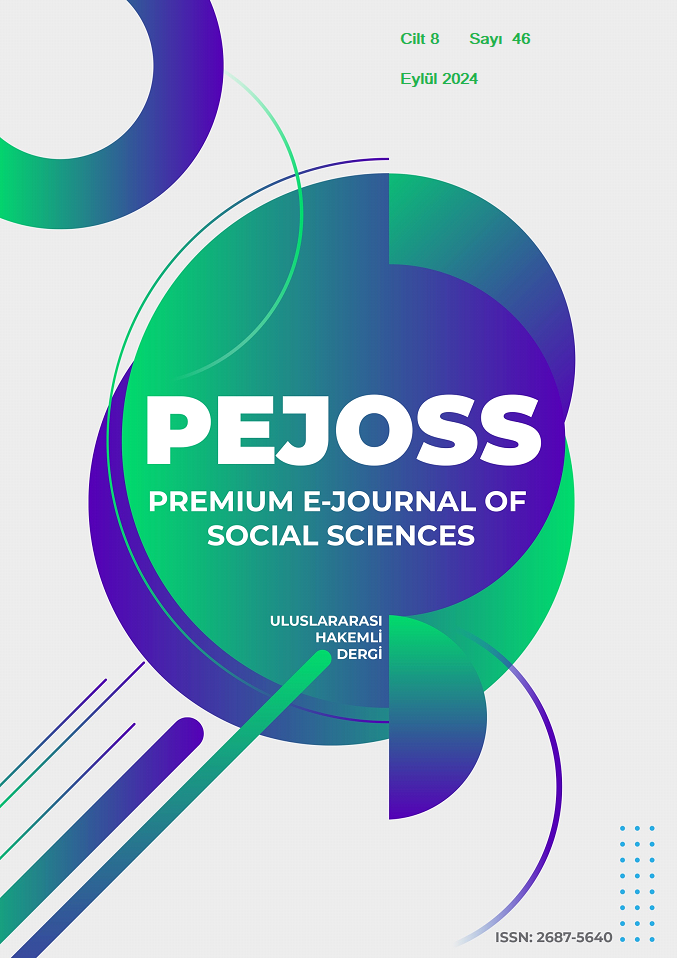Finansal Gelişme ile Genç İşsizlik Arasındaki Bağlantı: Ekonometrik Bir Yaklaşım
DOI:
https://doi.org/10.5281/zenodo.13881605Anahtar Kelimeler:
ARDL, Finansal gelişme, Genç işsizlikÖzet
Bireylerin istihdam edilmesi hem bireyin kendisi hem de toplum açısından oldukça önemli bir konudur. Bu nedenle, aktif olarak işgücüne katılanlara işgücü piyasasına katılma fırsatının garanti edilmesi ve böylece sosyal sınıfların ve bölünmelerin oluşmasının önlenmesi esastır. Bir ülkenin geleceğinin teminatı olan gençler, emeğin istihdamı konusunda en kırılgan kesimlerin başında gelmektedir. Bu durum genç işsizliği konusunun önemini artırmaktadır. Hızla küreselleşen dünyada çıktı üretimini ve tüketimi artıran finansal gelişmeler ülkelerin ekonomik ve sosyal gelişiminde önemli rol oynamaktadır. Dolayısıyla bu çalışmanın amacı, Türkiye örnekleminde finansal gelişme ile genç işsizlik arasındaki bağlantıyı ortaya koymaktır. Çalışma veri kısıtı dolayısıyla 1988-2021 dönemi kapsamaktadır. ARDL yönteminin kullanıldığı çalışmanın bulguları, finansal gelişmenin belirtilen dönem boyunca genç işsizliği üzerinde önemli bir negatif etkiye sahip olduğunu göstermektedir.
İndirmeler
Referanslar
Acemoglu, D. (2001). Credit market imperfections and persistent unemployment. European Economic Review, 45(4-6), 665–679.
Açdoyuran, B., & Kılıç, N. Ö. (2018). BRICS ülkelerinde finansal gelişme ve büyüme ilişkisi: Panel veri analizi. IKSAD II – International Conference on Social Sciences. 1109–1124.
Afonso, A., & Blanco-Arana, M. C. (2023). Unemployment and financial development: evidence for OECD countries. Comparative Economic Studies, 1–23.
Arco-Tirado, J. L., Fernández-Martín, F. D., & Jagannathan, R. (2021). No jobs, no hope: The future of youth employment in Spain. In The growing challenge of youth unemployment in Europe and America (pp. 51–78). Bristol University Press.
Ayadi, R., Naceur, S. B., & Goaied, M. (2019). Financial Development and Employment: New Evidence (No. 25). EMNES Working Paper.
Bbaale, E. (2014). Where are the Ugandan youth: Socio-economic characteristics and implications for youth employment in Uganda. Journal of Politics and Law, 7(1), 37–63.
Chen, T. C., Kim, D. H., & Lin, S. C. (2021). Nonlinearity in the effects of financial development and financial structure on unemployment. Economic Systems, 45(1), 1–17, 100766.
Chen, T. C., Kim, D. H., & Lin, S. C. (2021). Nonlinearity in the effects of financial development and financial structure on unemployment. Economic Systems, 45(1), 100–766.
Dao, M. C., & Liu, L. Q. (2017). Finance and employment in developing countries: The working capital channel. International Monetary Fund.
Dickey, D., & Fuller, W. (1981). Likelihood ratio statistics for autoregressive time series with a unit root. Econometrica, 49(4), 1057–1072.
Emekaraonye, C. F., Madubuike, K. O., Onuoha, F. C., & Mbadiwe, M. M. (2023). Reduction of youth unemployment through rural banks' credit: New empirical evidence in Nigeria. Evangel International Journal of Arts and Social Sciences, 3(2), 38–48.
Ezekoye, B. N. (2014). Youth self-employment and the emerging software development industry. Tackling Youth Unemployment, 367–383.
Fatokun, D. I., Folarin, E. M., & Agbawn, M. O. (2023). Impact of credit to private sector on youth unemployment rates in Nigeria (1991-2021). International Conference on Africa’s Sustainable Development (ICASUD) 2023.
Fitzenberger, B., Gürtzgen, N., & Pfeiffer, F. (Eds.). (2015). Determinants and Economic Consequences of Youth Unemployment at the Beginning of the 21st Century. Lucius & Lucius.
Franz, W. (1982). “Youth unemployment in the Federal Republic of Germany: Theory, empirical results, and policy implications: An economic analysis”. ISBN: 3-16-344583-7, J.C.B. Mohr.
Gatti, D., Rault, C., & Vaubourg, A. G. (2012). Unemployment and finance: how do financial and labour market factors interact? Oxford Economic Papers, 64(3), 464–489.
Hajdu, J. (2014). Legal Protection of Unemployed Young People in Europe. Tackling Youth Unemployment, 27–55.
ILO, (2022). Global employment trends for youth 2022: Investing in transforming futures for young people. https://doi.org/10.54394/QSMU1809
Kanberoğlu, Z. (2014). Finansal sektör gelişimi ve işsizlik: Türkiye örneği. Ekonomik ve Sosyal Araştırmalar Dergisi, 83–93.
Kim, D. H., Chen, T. C., & Lin, S. C. (2019). Finance and unemployment: New panel evidence. Journal of Economic Policy Reform, 22(4), 307–324.
Mills, M., & Blossfeld, H. P. (2006). Globalization, uncertainty and the early life course: A theoretical framework 1. In H. P. Blossfeld, E. Klijzing & M. Mills (Eds.), Globalization, uncertainty and youth in society (pp. 1–23). Routledge.
Pagano, M., & Pica, G. (2012). Finance and employment. Economic Policy, 27(69), 5–55.
Pesaran, M. H., Shin, Y., & Smith, R. J. (2001). Bounds testing approaches to the analysis of level relationships. Journal of Applied Econometrics, 16(3), 289–326.
Phillips, P., & Peron, P. (1988). Testing for a unit root in time series regressions. Biometrika, 75(2), 335–346.
Raifu, I. A., Kumeka, T. T., & Aminu, A. (2024). Financial development and unemployment in MENA: Evidence from heterogeneous panel causality and quantile via moment regression. Journal of the Knowledge Economy, 15(1), 3512–3550.
Rakauskienė, O. G., & Ranceva, O. (2014). Youth unemployment and emigration trends. Intellectual Economics, 8(1), 165–177.
Wasmer, E., & Weil, P. (2004). The macroeconomics of labor and credit market imperfections. American Economic Review. 94, 944–963.
İndir
Yayınlanmış
Nasıl Atıf Yapılır
Sayı
Bölüm
Lisans
Telif Hakkı (c) 2024 Premium e-Journal of Social Sciences (PEJOSS)

Bu çalışma Creative Commons Attribution 4.0 International License ile lisanslanmıştır.


